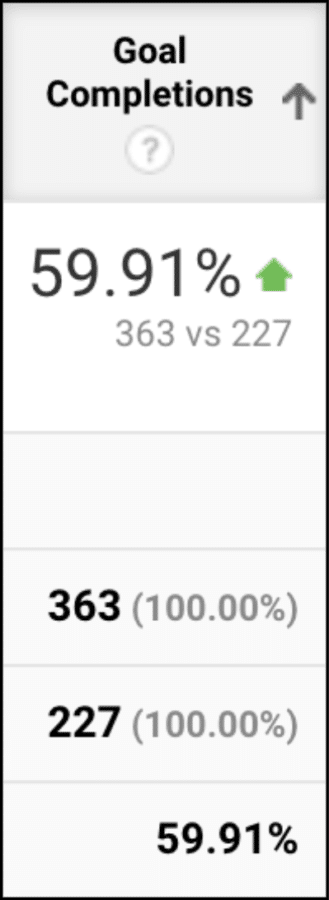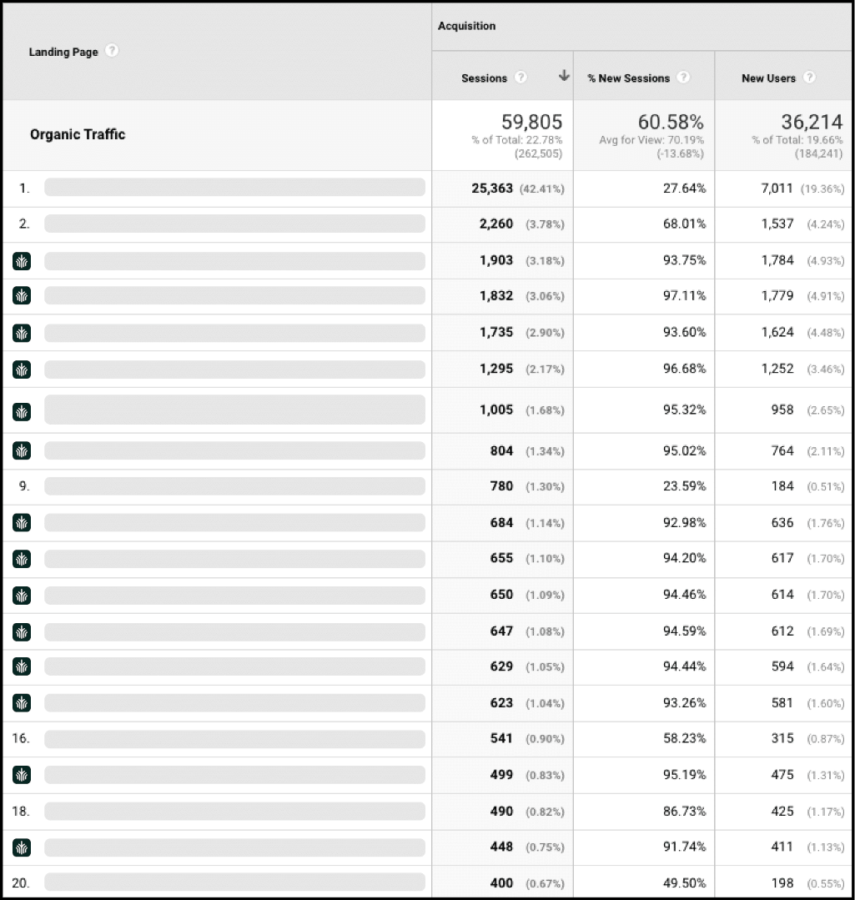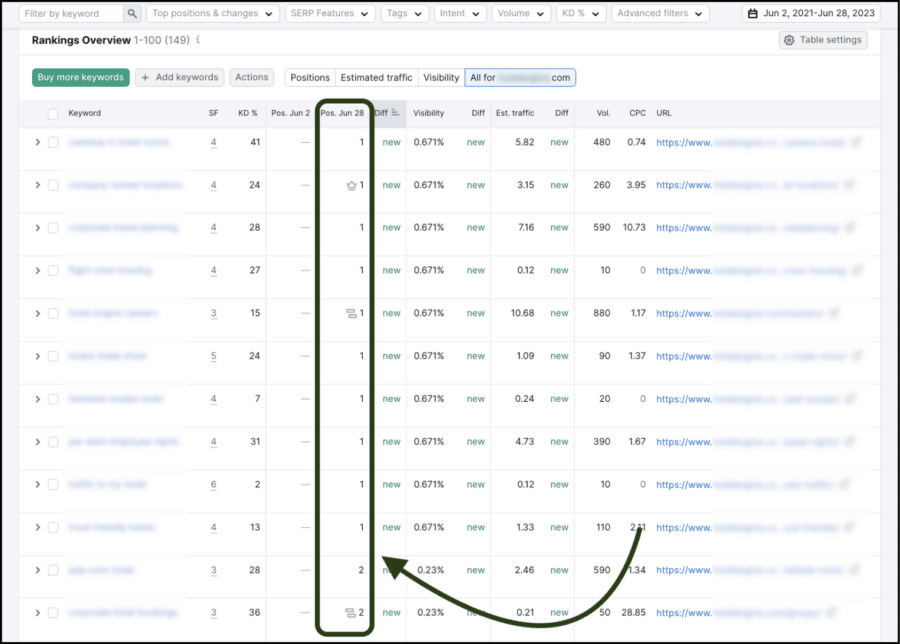SEO is so valuable for underdog companies.
Even in a hypersaturated market, it gives you the chance to outrank your competitors for valuable search terms so you can connect with your target customers.
In this case study, we’ll share how we helped one client increase website traffic by 229% in just two years. They have some very big competitors, and we still helped them to get 60% more leads each month.
Here’s the story:
The Client
We’ll to leave the client’s name out of this so we can share all of the details.
However, we will tell you that they’re a high-growth, VC-backed SaaS company focused on business travel.
(Think Booking.com or Tripadvisor, but with a subscription software component.)
We’ll call them “TravelSaaS” to keep things simple.
We started working with them in June 2021.
That month, their site saw 18,229 sessions from organic (non-ad) traffic, and 227 leads from those sessions.
They came to us because they wanted more.
More traffic. More leads. More market share.
They knew that ~18,000 monthly organic sessions wasn’t enough to compete with the giants in their industry. They felt that the right SEO strategy could help them to get their name out there, and they wanted us to build it for them.
The Strategy
We took a content-led approach to the TravelSaaS SEO strategy.
The goal was to publish valuable content for business travelers so that we could turn their site into a go-to source of information about business travel.
It’s a strategy we use for many clients. In our experience, it does two things to promote business growth:
- Attracts readers who are ready to buy: Search-optimized content is a great way to connect with potential customers in their research phase (and to pitch your product as the right solution).
- Builds trust with readers who might want to buy in the future: Not everyone needs the product right now, but good content can make potential customers remember your brand name.
Whenever a business traveler or travel manager went searching for advice on trip planning, we wanted our client’s website to show up with lots of helpful information to share.
Over time, this would help us to start “ranking for keywords”, or appearing toward the top of Google in common searches.
The Work
We started out gradually, writing four articles per month before scaling up in November 2021.
Our work for TravelSaaS fell into four overarching categories:
- Identifying topics
- Creating content
- Helping Google find the content
- Promoting the content
Here’s what each of those steps looks like:
1. Identifying Topics
We started by asking ourselves what types of topics business travelers and their managers like to read about.
What questions do they type into Google when they’re planning a trip?
What questions aren’t being answered sufficiently in their competitors’ content?
What challenges do customers face that TravelSaaS can solve?
In order to answer these questions, we spent a lot of time analyzing their competitors’ websites. We figured out which blog articles drive the most organic traffic to those sites, which likely drive significant sales, and which ones we could realistically outrank in search engines.
We used this information to compile our editorial calendar. Our planned articles fell into four overarching categories:
-
- Business hotels: Articles about the best business hotels in various cities, best practices for booking hotel rooms, and more
- Corporate travel: Advice on defining company travel policies, setting up corporate travel insurance, etc.
- Corporate expenses: Content related to per diem, expense reimbursement, and so on
The calendar included a strategic mix of what we call Awareness Content (which drives a lot of top-of-funnel traffic) and Sales-Centric Content (which drives less traffic but more sales).
Read more about our different types of content here: The 5 Components of a Successful Content Strategy
2. Creating Content
Even though we do SEO, we always write our content for people, not search engines.
(Content written for search engines is always bad, and it usually doesn’t rank for very long if it ranks at all).
That said, once we’ve created a great resource for human readers, we take specific measures to help search engines understand its quality.
For instance, we optimize every piece of content for TF-IDF, or term frequency-inverse document frequency. In this process, we identify the keywords that appear in all or most of the competitor articles currently ranking for our target keyword.
This helps us to understand which subtopics those articles cover and, therefore, which subtopics we need to cover at the bare minimum if we want our article to compete.
3. Helping Google Find the Content
One of the main purposes of SEO is to help Google find your website and to understand what type of information you offer searchers.
We take a lot of different measures in this regard, such as:
- Writing keyword-optimized meta titles for every page to tell Google what each page is about and which searches to include it in
- Eliminating any code that might prevent Google from adding certain pages to their index
- Linking key pages to each other to make it easy for Google to identify the most important ones
- Manually submitting each new page to Google so we know that it’s on their radar
In the case of TravelSaaS, we worked with their development team to build out a series of unique subdomains within their blog. Rather than hosting all of the blog articles under the /blog/ subdomain, we added unique “silos” for each of our content categories.
So instead of a new article’s URL looking like this:
www.travelsaas.com/blog/new-blog-article
… they ended up looking like this:
www.travelsaas.com/blog/business-hotels/new-blog-article1
or this:
www.travelsaas.com/blog/corporate-travel/new-blog-article2
or this:
www.travelsaas.com/blog/corporate-expenses/new-blog-article3
In our experience, this type of structure helps Google recognize that a website has a lot of content about a particular topic (not just one or two articles).
When someone searches for content related to business travel or corporate expenses, Google knows that TravelSaas is a go-to source of information with a library of content to show searchers.
They’re more likely to show that content in search results because they know that TravelSaaS are experts on the topic.
4. Promoting the Content
Content promotion is crucial in the early days after publishing. Sharing it on the client’s social channels can help to bring attention to new pieces before they’ve started to rank for their target keywords.
We put a particularly strong focus on promoting TravelSaaS’ content through link building, or building links to their website from other websites. The quality and quantity of websites that link to a page are important to Google’s ranking algorithm, as it sees links as a sign that other people found the page valuable.
Our link-building strategy for TravelSaas is one that we use for many clients:
- We build relationships with leading bloggers in similar industries
- We look for collaboration opportunities with those bloggers (sharing quotes or data to use in their articles, contributing new content to their site, etc.).
- We get a link to the client’s site in the process.
Our goal is to treat links as the catalyst to get content to rank. We identify how many links the page should need to rank in the top ten using our Root Domain Benchmark Tool.
We might set out to build five links to a new blog article to get it to the first page of search results. Assuming we’ve created a great resource for users, that ranking will stick, and the client will get leads every month from this new article.
Note: When TravelSaaS came to us, they had backlinks from 350 websites. Over the next two years, we helped them to earn backlinks from more than 1,300 sites!
The Results
To recap:
We started working with TravelSaaS in June 2021.
That month (before we published any content or made any updates), their site saw 18,229 sessions from organic search.
The same month, they received 227 leads from organic sessions.
Here are the metrics for June 2023, three years after we started working for TravelSaaS:
With 59,155 organic sessions in June 2023, organic sessions were up 229%.
TravelSaaS received 363 organic traffic leads that month, a 59.9% growth in leads from when we first started working with them.
The content we created now accounts for 14 of the 20 highest organic traffic drivers on their site.
We achieved these results largely in part to the improvements we saw in keyword rankings.
In June 2021, TravelSaaS appeared in the search results for less than 1% of their “target” keywords (i.e. the keywords likely to drive the most leads).
Two years later, they appeared in the top 20 search results for 97 of those keywords (out of 149 total).
Conclusion
The challenge of being a startup in a saturated industry is getting your name out there — and convincing people to work with you instead of your well-established competitors.
SEO and content marketing can help you overcome these challenges. A well-optimized website and some high-quality content can help you to outrank even the biggest competitors so you can start connecting with your target customers.
Think we might be able to help your business grow? Let’s schedule a call!
SCALE YOUR ORGANIC TRAFFIC
Subscribe to our monthly newsletter









